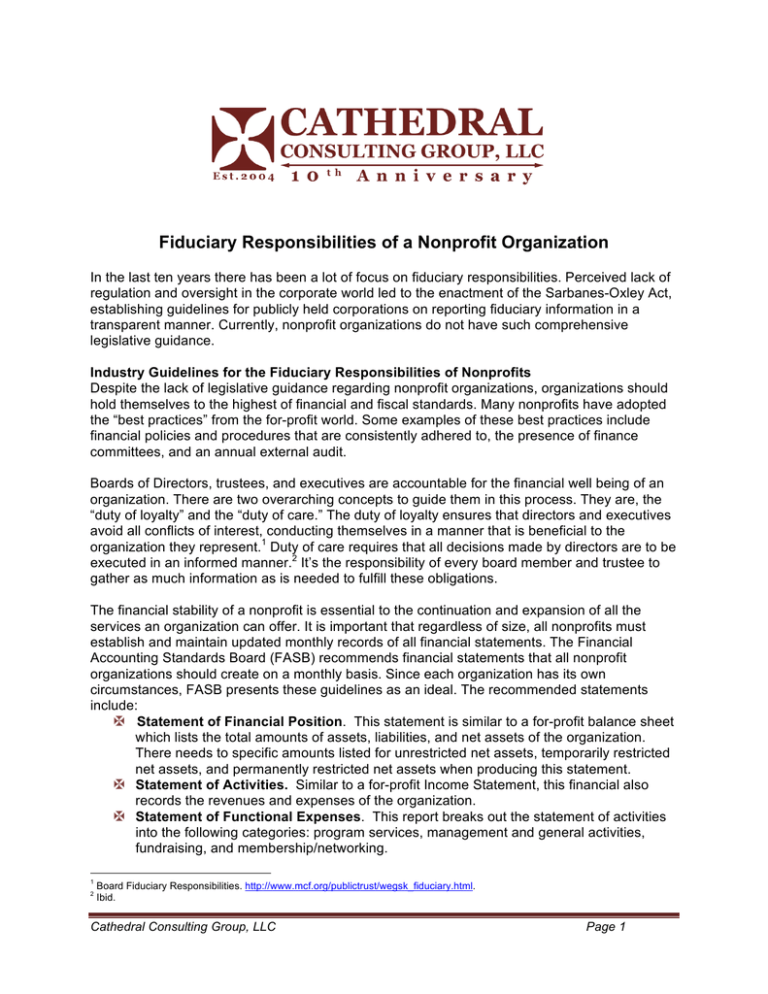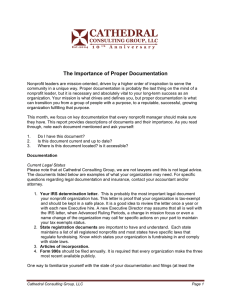Fiduciary Responsibilities of a Nonprofit Organization
advertisement

Fiduciary Responsibilities of a Nonprofit Organization In the last ten years there has been a lot of focus on fiduciary responsibilities. Perceived lack of regulation and oversight in the corporate world led to the enactment of the Sarbanes-Oxley Act, establishing guidelines for publicly held corporations on reporting fiduciary information in a transparent manner. Currently, nonprofit organizations do not have such comprehensive legislative guidance. Industry Guidelines for the Fiduciary Responsibilities of Nonprofits Despite the lack of legislative guidance regarding nonprofit organizations, organizations should hold themselves to the highest of financial and fiscal standards. Many nonprofits have adopted the “best practices” from the for-profit world. Some examples of these best practices include financial policies and procedures that are consistently adhered to, the presence of finance committees, and an annual external audit. Boards of Directors, trustees, and executives are accountable for the financial well being of an organization. There are two overarching concepts to guide them in this process. They are, the “duty of loyalty” and the “duty of care.” The duty of loyalty ensures that directors and executives avoid all conflicts of interest, conducting themselves in a manner that is beneficial to the organization they represent.1 Duty of care requires that all decisions made by directors are to be executed in an informed manner.2 It’s the responsibility of every board member and trustee to gather as much information as is needed to fulfill these obligations. The financial stability of a nonprofit is essential to the continuation and expansion of all the services an organization can offer. It is important that regardless of size, all nonprofits must establish and maintain updated monthly records of all financial statements. The Financial Accounting Standards Board (FASB) recommends financial statements that all nonprofit organizations should create on a monthly basis. Since each organization has its own circumstances, FASB presents these guidelines as an ideal. The recommended statements include: Statement of Financial Position. This statement is similar to a for-profit balance sheet which lists the total amounts of assets, liabilities, and net assets of the organization. There needs to specific amounts listed for unrestricted net assets, temporarily restricted net assets, and permanently restricted net assets when producing this statement. Statement of Activities. Similar to a for-profit Income Statement, this financial also records the revenues and expenses of the organization. Statement of Functional Expenses. This report breaks out the statement of activities into the following categories: program services, management and general activities, fundraising, and membership/networking. 1 2 Board Fiduciary Responsibilities. http://www.mcf.org/publictrust/wegsk_fiduciary.html. Ibid. Cathedral Consulting Group, LLC Page 1 Statement of Cash Flows. This is similar to a for-profit cash flow statement in that it specifies the source of capital flowing through the organization. Because financial statements should be prepared on an accrual basis, the cash flow statement helps the organization understand how its operations affect its cash position.3 Financial Statement Disclosures. This statement is required by FASB to denote specific nonprofit entities such as contributed services, temporarily restricted support, long-life gifted assets, collection items, Board designations, permanent and temporary restrictions, promises to give, and depreciation in the same manner as for-profits are required to denote disclosures.4 The preparation of financial statements is equally important internally as it is to the general public. These statements provide each organization with the ability to compare quarterly and annual budgets to actual expenses and revenues, generating the ability to budget for the future. Externally, the statements allow donors to feel secure about the financial state of the organization. It also gives the organization a sophisticated and professional appearance. While many organizations argue it is not necessary to prepare these monthly, Cathedral’s experiences show that monthly financials are both possible and a good discipline. Nonprofit organizations should consider annual external audits for both the activities and financials of the organization. Cathedral encourages Boards and Executive Directors to remember an audit is beneficial to affirm proper handling of funds entrusted during their term and to show donors the seriousness the entity takes in such responsibilities. Some organizations may find funding annual audits difficult, but we recommend audits no less than every two years. Government Acts Concerning the Fiduciary Responsibilities of Nonprofits All of the above are non-legislative guidelines that should direct the treasurer, executive director and finance committee in designing their own fiscal policy. There are, however, several legislative acts that apply to nonprofits in the area of fiduciary management. These acts were designed specifically to address the investment of nonprofit funds. Uniform Management of Institutional Funds Act (UMIFA) The Uniform Management of Institutional Funds Act was originally created as a response to prior concerns of endowment managers making investments on a total-return basis. These managers were reluctant to make distributions on capital gains for current needs, limiting their long-term growth potential. The Uniform Management of Institutional Funds Act (UMIFA) was established and allows a charity’s board to use a fund’s capital appreciation for current needs. UMIFA also allows the transference of investment decision making to a board committee, employees, or external investment advisors. The Act also contains other investment requirements. The Uniform Prudent Investor Act The Uniform Prudent Investor Act is similar to that of UMIFA but with more specific guidelines regarding investment management. Uniform Prudent Investor Act (UPIA) applies to trusts under the control of trustees, excluding any funding controlled by charities for their own account.5 3 See our monthly topic on “Financial Statements” for a better understanding of the accrual accounting process. www.cathedralconsulting.com/resources/non-profit. 4 Financial Statements for Not-For-Profit Organizations. http://www.1800net.com/nprc/fasb117.html 5 Uniform Prudent Investor Act. http://www.law.upenn.edu/bll/archives/ulc/fnact99/1990s/upia94.pdf Cathedral Consulting Group, LLC Page 2 UPIA requires that the trustee must follow the guidelines of the trust when considering diversification or else diversify completely. All investments are to be judged as a whole portfolio and the investment strategy must exhibit objectives regarding risk and return that meet the needs of the organization. One specification of UPIA is that the trustee can place the control of investments onto other individuals if deemed necessary. The Internal Revenue Service (IRS) The IRS acknowledges program-related investments but under certain guidelines. Programrelated investments are categorized as having the primary objective being to fulfill at least one of the foundations exempt purposes, the income or appreciation of the investment is not for a significant purpose, and that the purpose of the investments is not to support any lobbying activities.6 If an investment does provide a large return, the IRS does not assume that the investment was preformed for a significant purpose in benefiting a cause outside the organization. The program-related investments must have been entered with the understanding that they would benefit the exempt purpose of the organization and not solely for monetary gains. If the investments are found to not be program-related, they are subject to taxation by the IRS. Each state carries its own regulations on the investment opportunities for nonprofit organizations. It is important to be aware of any specific regulations or acts that pertain to the state in which you conduct your activities. For additional information on endowments, please review Philip J. Clements’ “Endowments in the Current Financial Crisis” white paper, available at www.CathedralConsulting.com. Additional Information 1. Basic Overview of U.S. Nonprofit Financial Management. The Free Management Library provides basic insight on the various financial processes an organization should have in place to ensure proper financial management. http://www.managementhelp.org/finance/np_fnce/basics.htm Peter Giersch is COO of Cathedral Consulting Group, LLC and a Managing Director in the Midwest Office. For more information, please visit Cathedral Consulting Group LLC online at www.cathedralconsulting.com or contact us at info@cathedralconsulting.com. 6 Program-related Investments. http://www.irs.gov/charities/foundations/article/0,,id=137793,00.html Cathedral Consulting Group, LLC Page 3





